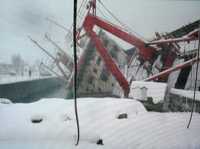
Feeling oh so very righteous about our recent train trip on Amtrak, I decided to look into what the media sources have to say about what's going on with this federally subsidized entity. While ridership on the railroad is up nearly 14% for July of 2008, probably due mostly to increased fuel costs for auto travel, and certain routes on certain dates are sold out, it's obvious that Amtrak is struggling to keep up service and on time records. In fact, they don't really want any more riders. The equipment in use is often 30 years old, and on some routes is already filled. Our travels between Charlottesville and Washington led us to believe the
Crescent is well used and nearly full of passengers. But what happens to the ridership as the train heads into North and South Carolina?
It was the leg between Albany and Montreal that was the most problematic in terms of efficiency and time savings. The Transportation Energy Databook shows that Btu's per passenger mile for
autos is 3512, and for
Amtrak it is 2650. But this is over the entire system, and the
Adirondack would have to be far from one of the more efficient routes. The roadbed north of Saratoga is pretty worn, limited to a single track that must be shared with freight. Add in the two hour + customs delay each way at Rousses Point for the border crossing between the U.S. and Canada, and the frustration level rises along with the inefficiency.
All of which still doesn't negate the carefree feeling of traveling without a car - or should I say carfree feeling of traveling without care? By it's nature this sort of travel necessitates that one visit larger, more populous destinations. To an extent this is fine. But I think we may be souring on travel to large and mid sized cities where trains are located. It was certainly a pleasant alternative to be able to go away for a week and not be concerned with driving, parking, fueling. (Although it must be confessed that we took advantage of Mark Hobson's offer of a free car and a house while visiting in the Adirondacks.) Having not been to any of the stops before - other than Manhattan island - we were perfectly satisfied with the range we were able to reach on foot and via buses and metros.
But the train... I keep coming back to trying to describe the train experience, for I think
that's what this entry was really supposed to be about. There is no question that long distance train travel beats flying or driving in a car or a bus. It may not be inexpensive. But most likely the true costs of the other three modes are not really calculated into the fare. Well, trains probably aren't either. Even at the prices charged, the system still needs annual governmental support. The ability to move about the train while traveling through the landscape is surely the most attractive feature of this mode of transportation. The seats and legroom are larger than the other three modes. Add in the ability to bring electronic devices for computing and watching movies or teevee and listening to music to the traditional diversions of reading and sleeping (for some individuals - I always get a sore neck when trying to sleep sitting up), and there is usually plenty to keep you occupied for several hours. Beyond that, when approaching six or seven hours, the confinement factor begins to be a group malaise. Everybody wants to get out of there, and shows it with the endless pacing back and forth to the cafe car and the restrooms.
So what the hell has this got to do with photography? Not much, but
here are a few snaps from our
train experience. (Click the lead image
twice to start a slide show.) I'll try to get more material together in the coming week.
 Sunday, September 14, 2008 at 09:17PM
Sunday, September 14, 2008 at 09:17PM 































